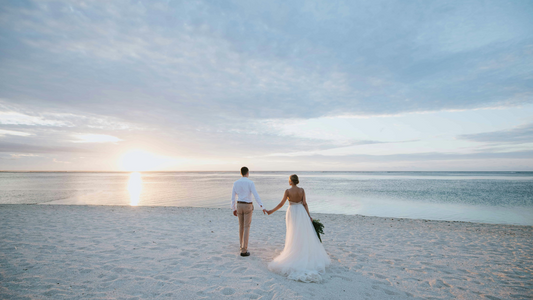Your wedding ring is a symbol of everlasting love and commitment, a tangible reminder of the vows exchanged on your special day. With so many styles, metals, and settings to choose from, finding the perfect wedding ring can feel like a daunting task. Fear not! In this guide, we'll walk you through everything you need to know to choose the perfect wedding ring that reflects your personal style and celebrates your unique love story.
1. Consider Your Lifestyle and Personal Style
When choosing a wedding ring, it's essential to consider your lifestyle and personal style. Think about factors such as your profession, hobbies, and daily activities that may affect the durability and practicality of your ring. If you lead an active lifestyle or work with your hands, you may prefer a more durable metal such as platinum or titanium. Similarly, consider your personal style preferences, whether you prefer classic elegance, modern simplicity, or vintage charm.
2. Explore Different Styles
Wedding rings come in a variety of styles, from classic bands to intricate designs with diamonds and gemstones. Take the time to explore different styles and find one that resonates with you and your partner. Classic wedding bands are timeless and versatile, while more elaborate designs can add a touch of sparkle and personality. Consider trying on different styles to see how they look and feel on your finger before making a decision.
3. Learn About Different Metals
The metal you choose for your wedding ring plays a significant role in its appearance, durability, and cost. Common metals for wedding rings include gold, platinum, palladium, titanium, and tungsten. Each metal has its unique properties and characteristics, so it's essential to learn about the pros and cons of each before making a decision. Consider factors such as color, durability, and price when choosing the metal for your wedding ring.
- Gold: Gold is a classic choice for wedding rings, known for its timeless elegance and warm glow. Gold wedding rings come in a variety of colors, including yellow, white, and rose gold, allowing you to choose the perfect hue to complement your skin tone and personal style.
- Platinum: Platinum is a durable and hypoallergenic metal that is prized for its purity, strength, and natural white luster. Platinum wedding rings are luxurious and sophisticated, making them an excellent choice for those seeking a high-quality and long-lasting ring.
- Palladium: Palladium is a rare and precious metal that shares many similarities with platinum, including its hypoallergenic properties and natural white color. Palladium wedding rings are lightweight, durable, and resistant to tarnishing, making them an excellent choice for those with active lifestyles.
- Titanium: Titanium is a lightweight and durable metal that is known for its strength and resilience. Titanium wedding rings are hypoallergenic, corrosion-resistant, and available in a variety of finishes and colors, making them a popular choice for modern couples seeking a contemporary and low-maintenance ring.
- Tungsten: Tungsten wedding rings are incredibly durable and scratch-resistant, making them an excellent choice for those with active lifestyles or demanding professions. Tungsten rings are available in a variety of styles and finishes, including polished, brushed, and hammered, allowing you to find the perfect ring to suit your taste.
4. Choose the Right Setting
The setting of your wedding ring refers to how the diamonds or gemstones are held in place on the band. Common settings for wedding rings include prong, channel, bezel, pave, and tension settings. Each setting has its unique look and feel, so it's essential to choose one that complements the style of your ring and enhances the beauty of the stones.
- Prong Setting: In a prong setting, small metal prongs hold the diamond or gemstone in place, allowing maximum light to enter and accentuating its brilliance and sparkle. Prong settings are classic and versatile, suitable for a wide range of diamond shapes and sizes.

- Channel Setting: In a channel setting, diamonds or gemstones are set into a channel cut into the metal band, creating a sleek and modern look. Channel settings are popular for wedding rings with multiple stones or for those seeking a more contemporary and streamlined design.

- Bezel Setting: In a bezel setting, the diamond or gemstone is surrounded by a metal rim that holds it securely in place. Bezel settings offer excellent protection for the stone and have a clean and minimalist appearance, making them an excellent choice for those seeking a simple and understated ring.

- Pave Setting: In a pave setting, small diamonds are set closely together and held in place by tiny beads or prongs, creating a surface that appears to be paved with diamonds. Pave settings add sparkle and dimension to the ring and are perfect for those seeking maximum brilliance and glamour.

- Tension Setting: In a tension setting, the diamond or gemstone is held in place by the pressure of the metal band, creating the illusion that it is floating in mid-air. Tension settings are modern and innovative, perfect for those seeking a unique and eye-catching ring design.

5. Get Sized Properly
Once you've chosen the style, metal, and setting for your wedding ring, it's essential to get sized properly to ensure a comfortable fit. Visit a reputable jeweler to have your finger measured accurately, as the size of your ring can vary depending on factors such as the width of the band and the shape of your finger. Keep in mind that your ring size may change over time, so it's a good idea to have your finger measured periodically, especially if you're planning to wear your wedding ring for many years to come.





